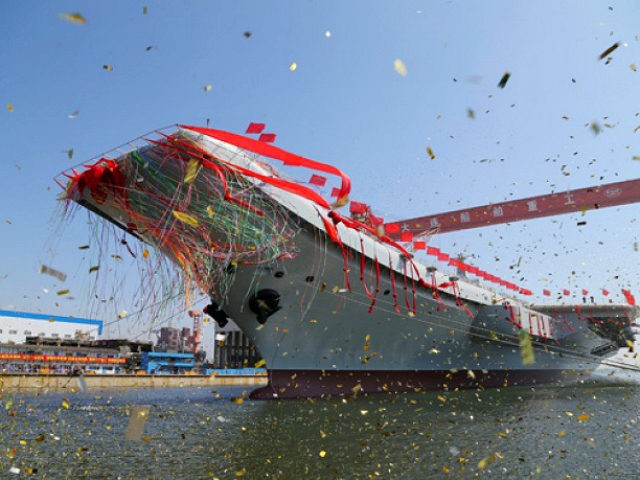China launched a 50,000-ton aircraft carrier on Wednesday, its second carrier after the Soviet-built Liaoning, which China purchased from Ukraine. The new ship represents a milestone because it is the first domestically constructed carrier for China.
The vessel does not have a name yet, though some Chinese sources say it will most likely be named Shandong. According to the Associated Press, it will be formally commissioned “sometime before 2020, after sea trials and the arrival of its full air complement.”
Although unnamed and incomplete, the ship was given a splashy launch when it went into the water at the northeastern port of Dalian –festooned with red flags, toasted with champagne, and serenaded with the horns of every other ship in the harbor.
The AP runs through an all-star Chinese military and political guest list for the ceremony, ominously including Vice Admiral Shen Jinlong, “a former commander of the South Sea Fleet responsible for defending China’s claim to virtually the entire South China Sea.”
The Associated Press reports:
China is believed to be planning to build at least two and possibly as many as four additional carriers, with one of them, the Type 002, reported to be already under construction at a shipyard outside Shanghai. They are expected to be closer in size to the U.S. Navy’s nuclear-powered 100,000-ton Nimitz-class ships, with flat flight decks and catapults to allow planes to launch with more bombs and fuel aboard.
The new ship, like the Liaoning, has the old-fashioned Russian “ski jump” launch design, which makes every takeoff extra exciting.
The South China Morning Post related China’s declaration that the new ship will “enhance global security,” including security for China’s all-important New Silk Road trade route. This commitment will not be taken very seriously by any nation with interests in the South China Sea.
The SCMP recalls Japan’s anger when the Liaoning first ventured into the western Pacific last year; the Associated Press notes that Japan, India, and Taiwan have grown interested in building the kind of submarine that excels at sinking aircraft carriers.
The BBC observes that China’s carriers are “technologically inferior” to the ten carriers currently operated by the United States Navy, relying on conventional instead of nuclear power, but still represent a major step forward in both technological innovation and military power for China. A side-by-side comparison prepared by Forbes shows that American carriers can launch almost three times as many aircraft as the Chinese models, using electromagnetic catapults instead of the “ski jump” ramp.
The aging Liaoning will likely become a training vessel, while China expedites the construction of at least one more domestically-produced carrier so it can keep a carrier at sea constantly. It took about four years to design and build the new ship.

COMMENTS
Please let us know if you're having issues with commenting.